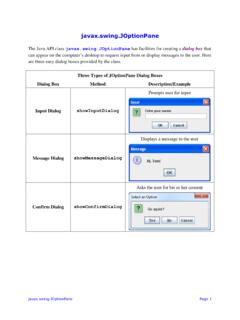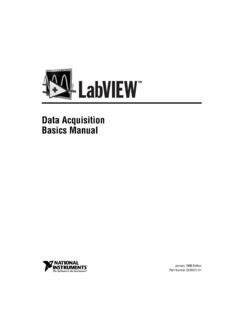Transcription of LabVIEW Programming Examples - Kansas State University
1 Telemark University College Department of Electrical Engineering, Information Technology and Cybernetics Faculty of Technology, Postboks 203, Kj lnes ring 56, N-3901 Porsgrunn, Norway. Tel: +47 35 57 50 00 Fax: +47 35 57 54 01 LabVIEW Programming Examples Hans-Petter Halvorsen Telemark University College Department of Electrical Engineering, Information Technology and Cybernetics Faculty of Technology, Postboks 203, Kj lnes ring 56, N-3901 Porsgrunn, Norway. Tel: +47 35 57 50 00 Fax: +47 35 57 54 01 Table of Contents 1 - Customizing the LabVIEW Environment 2 - Wires and Variables 3 - Strings 4 - Arrays 5 - SubVIs 6 - Clusters 7 - Formula Node 8 - Debugging 9 - Project Explorer 10 - State Machine Telemark University College Department of Electrical Engineering, Information Technology and Cybernetics Faculty of Technology, Postboks 203, Kj lnes ring 56, N-3901 Porsgrunn, Norway.
2 Tel: +47 35 57 50 00 Fax: +47 35 57 54 01 Customizing the LabVIEW Environment Description: LabVIEW has lots of possibilities for customizing the appearance and the use of the LabVIEW environment. Select from the Tools menu. Requirements: LabVIEW 2009 Task: In this example you will customize the LabVIEW Environment so it bests fits your demands. The example will go through the most important settings in the Options window (Select from the Tools menu). The default settings is not necessary the best, here are some recommendations for setting up the LabVIEW environment. Try the different settings above and see the difference and make your own personal choice. Setting: Place front panel terminals as icons (Category: Block Diagram General) (My Favorite) Hans-Petter Halvorsen Blog: ~hansha/ Comments: The setting to the right is my personal (and recommended) favorite.
3 For LabVIEW beginner is the setting to the left easier to understand, but it takes too much space in the Block Diagram! Setting: Enable automatic wire routing (Category: Block Diagram Wiring) (My Favorite) Comments: This prevents LabVIEW from automatically connecting adjacent blocks. The setting to the right is my personal (and recommended) favorite. When you use the setting to the right you have more control and you may easy switch between the tools using the Tab key. Although it seems useful to have auto wiring enables, it is my experience that the auto wiring is a little annoying since it tends to draw wires between blocks when you do not want any wire, etc. Setting: Show front panel grid (Category: Front Panel Front Panel Grid) (My Favorite) Comments: This setting shows a Grid pattern on the Front Panel in Edit mode.
4 I think this setting is distracting, but that is my opinion. Note! You may set the same setting for the Block Diagram. Setting: Change Visible Categories The next setting is not located in the Options window, but I think it is worth mention is this context. In the Functions or Controls palette, you may select which Categories that should be visible. I recommend that you Select All . Telemark University College Department of Electrical Engineering, Information Technology and Cybernetics Faculty of Technology, Postboks 203, Kj lnes ring 56, N-3901 Porsgrunn, Norway. Tel: +47 35 57 50 00 Fax: +47 35 57 54 01 LabVIEW Wires and Variables Example Description: In text-based Programming languages, you store and access data with functions through the use of variables.
5 In the LabVIEW graphical Programming language, wires implicitly handle all of the data storage and access that are associated with variables in text-based languages. Think of wires as a path for data to flow. Data comes into block diagram objects through a wire and can leave only through a wire. Local (or Global) Variables are used to pass data when a wire in some situations cannot be used. Requirements: LabVIEW 2009 Task: Wires: Create a program where you use Wires and Shift Registers to update data as shown below. Task: Local Variables: The Local Variable item is located on the Structures palette on the Block Diagram. When you place a Local variable on the Block Diagram, it looks like a Question mark as seen below.
6 Then you right-click on the Local variable and choose Select Item and select which Control/Indicator you want to connect it to. Another way to create a local variable is to right-click on a Control/Indicator either on the Front Panel or the Block Diagram and select Create Local Variable . Hans-Petter Halvorsen Blog: ~hansha/ Task: Create the same program as in the previous task and use Local Variables instead. Task: Global Variables: Use global variables to access and pass data among several VIs. When you create a global variable, LabVIEW automatically creates a special global VI, which has a front panel but no block diagram. The Global Variable item is located on the Structures palette on the Block Diagram.
7 When you place a Local variable on the Block Diagram, it looks like a Question mark with a globe, as seen above. Double-clink on the item in order to create the Global Variable. Task: Create 2 VIs that uses a Global variable to exchange data between them. Example: Telemark University College Department of Electrical Engineering, Information Technology and Cybernetics Faculty of Technology, Postboks 203, Kj lnes ring 56, N-3901 Porsgrunn, Norway. Tel: +47 35 57 50 00 Fax: +47 35 57 54 01 LabVIEW String Example Description: Working and manipulating with strings is an important part in LabVIEW development. On the Front panel we have the following String controls and indicators available from the Control palette: On the Block Diagram we have the following String palette available from the Functions palette in LabVIEW : In this Example you will learn how to use strings and string manipulation in LabVIEW .
8 Requirements: LabVIEW 2009 Task: Concatenate Strings. Create the following: Hans-Petter Halvorsen Blog: ~hansha/ Task: Search and Replace String. Create the following: Task: Match Pattern. Create the following: Task: Format into String. Create the following: Task: String to Number and Number to String. Create the following: Task: Create the following Example. You will need all you have learned above and Telemark University College Department of Electrical Engineering, Information Technology and Cybernetics Faculty of Technology, Postboks 203, Kj lnes ring 56, N-3901 Porsgrunn, Norway. Tel: +47 35 57 50 00 Fax: +47 35 57 54 01 LabVIEW Arrays Example Description: Working and manipulating with Arrays is an important part in LabVIEW development.
9 Arrays are very powerful to use in LabVIEW . In all your applications you would probably use both One-Dimensional Arrays and Two-Dimensional Arrays. On the Front Panel using the Control palette we can create an array as follows (Array, Matrix & Cluster subpalette): You drag and drop the empty Array on the Front Panel, next you find a Control or Indicator (Numeric, String, Boolean, etc,) and drag it into the empty Array. You can create an Array of (almost) any kind of Control or Indicator. 2D or multidimensional Array? Just drag the mouse in the Index display to the left and increase the dimension. On the Block Diagram we have the following Array palette available from the Functions palette in LabVIEW : Use the Array functions to create and manipulate arrays.
10 The most useful Array functions are: Hans-Petter Halvorsen Blog: ~hansha/ Array Size Index Array Delete from Array Search 1D Array Initialize Array Build Array Array Subset Array Constant All these functions are basic (but very useful) array functions you will probably be using in all your applications and VIs. Task: Build Array. This function concatenates multiple arrays or appends elements to an n-dimensional array. Try the simple example below. This example using the Build Array function inside a For loop in order build an array with 10 elements. Task: Index Array. This function returns the element or subarray of n-dimension array at index. It is always useful to find a specific value in an array.


